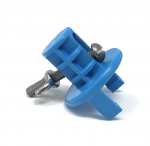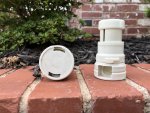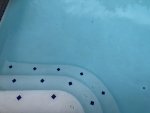Hello all, I have recently purchased a home with a 17x36 ft gunite IG pool I am ballparking around 35k gallons (old school diving deep end) and I could use some advice in a few areas. We closed on the 10th of June, and the pool has not been serviced since then. I had the pool looked at by a local service and they sold me a taylor 2005 kit that I thought was the newer FAS kit but was in fact not, so I am stuck with that at the moment. I had the water tested by a local pool place around the 20th and the chlorine was 15+ (I think their test capped at that), the calcium was around 500, so they had me put some scale inhibitor in, the alkalinity was high (dont have exact #), and the ph was 6.8, and they had me put in some base. The stabilizer was also high, but they didn't have me do anything with that yet.
Since then, I have not done anything, and retested it myself yesterday. The free chlorine, even diluting it as directed with the kit, is off the charts pink. The ph has come up to 7.4, the calcium is still around 500+, the alkalinity is high but I forgot to make the adjustment with the kit to account for the high chlorine, so that may be off, and the stabilizer is, according to my kit, somewhere well over 100. I interpreted this, perhaps erroneously, as "someone has dumped a truckload of dichlor/trichlor type stuff into my pool", and the previous owner told me he did put a bunch of "chlorine" in since he wasn't sure when I would get around to managing it.
I am assuming at this point, per the chemistry guide, with the CYA seemingly that high, I am just going to have to drain it and refill? I was guestimating draining it 1/3 to 1/2 and refilling from there, not sure if I need to do more. Tips at this point would be appreciated.
Additional questions!
1. The pool has a caretaker 99 in floor system, with multiple missing heads, and most of the rest nonfunctioning. From my youtube deep dive, it sounds like I may need to replace the diaphragm things in the valve (5 port), and then try replacing the missing heads. One guy told me the sleeve threads into which the heads go were probably stripped and it would never work, and I should just lock them all in place, forget about it, and get a robot. Advice would be appreciated.
2. I have an old automatic cover system from cover-pools inc. I had a local guy take it apart and the drum and motor are good but the cover is obviously in terrible shape as the original owners stopped using it a long time ago. It sounds like it will be around 3500 for new cover/glide mechanisms/anchor screws etc. There seems to be a love/hate thing going on with auto covers around here. I have young children I need to childproof the pool from, so it's either get this thing working, or get a pool fence for about 4500. I think the additional perks of the cover sound nice, they already had the guts put in place, which is the most expensive part, and I don't love the pool fence look, but I would like to hear people's experiences. Am I just getting myself into a money pit and will have to repair this thing once a year or something?
3. The pump was left on 24/7 by the previous owner, and is a 3HP (3.45 with SF multiplier) one speed centurion pump. From what I have read it seems pointless to run it 24/7, so I was thinking about cutting it back. Per the chart in pool school, a 3HP pump should turn over the pool twice in 8 hours, so 24/7 run time seems majorly excessive. I put a 4 hour break on it the past few days, and was thinking about upping it to 12 on/off. Seems like it would be best to do something like run 4/off 4, x 3, rather than a solid 12 hour block of no pump action?
4. Does it make any sense to buy a variable speed pump if my current pump is running fine, or should I just wait till it breaks down the line and switch to the more efficient variable speeds then?
Appreciate all the help.
Since then, I have not done anything, and retested it myself yesterday. The free chlorine, even diluting it as directed with the kit, is off the charts pink. The ph has come up to 7.4, the calcium is still around 500+, the alkalinity is high but I forgot to make the adjustment with the kit to account for the high chlorine, so that may be off, and the stabilizer is, according to my kit, somewhere well over 100. I interpreted this, perhaps erroneously, as "someone has dumped a truckload of dichlor/trichlor type stuff into my pool", and the previous owner told me he did put a bunch of "chlorine" in since he wasn't sure when I would get around to managing it.
I am assuming at this point, per the chemistry guide, with the CYA seemingly that high, I am just going to have to drain it and refill? I was guestimating draining it 1/3 to 1/2 and refilling from there, not sure if I need to do more. Tips at this point would be appreciated.
Additional questions!
1. The pool has a caretaker 99 in floor system, with multiple missing heads, and most of the rest nonfunctioning. From my youtube deep dive, it sounds like I may need to replace the diaphragm things in the valve (5 port), and then try replacing the missing heads. One guy told me the sleeve threads into which the heads go were probably stripped and it would never work, and I should just lock them all in place, forget about it, and get a robot. Advice would be appreciated.
2. I have an old automatic cover system from cover-pools inc. I had a local guy take it apart and the drum and motor are good but the cover is obviously in terrible shape as the original owners stopped using it a long time ago. It sounds like it will be around 3500 for new cover/glide mechanisms/anchor screws etc. There seems to be a love/hate thing going on with auto covers around here. I have young children I need to childproof the pool from, so it's either get this thing working, or get a pool fence for about 4500. I think the additional perks of the cover sound nice, they already had the guts put in place, which is the most expensive part, and I don't love the pool fence look, but I would like to hear people's experiences. Am I just getting myself into a money pit and will have to repair this thing once a year or something?
3. The pump was left on 24/7 by the previous owner, and is a 3HP (3.45 with SF multiplier) one speed centurion pump. From what I have read it seems pointless to run it 24/7, so I was thinking about cutting it back. Per the chart in pool school, a 3HP pump should turn over the pool twice in 8 hours, so 24/7 run time seems majorly excessive. I put a 4 hour break on it the past few days, and was thinking about upping it to 12 on/off. Seems like it would be best to do something like run 4/off 4, x 3, rather than a solid 12 hour block of no pump action?
4. Does it make any sense to buy a variable speed pump if my current pump is running fine, or should I just wait till it breaks down the line and switch to the more efficient variable speeds then?
Appreciate all the help.





